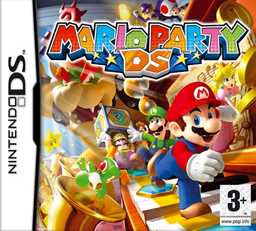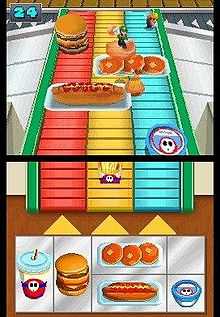Mario Party DS
| Mario Party DS | |
|---|---|
 European box art | |
| Developer(s) | Hudson Soft |
| Publisher(s) | Nintendo |
| Composer(s) | Hironobu Yahata Shinya Outouge |
| Series | Mario Party |
| Platform(s) | Nintendo DS |
| Release date(s) |
|
| Genre(s) | Party Minigame |
| Mode(s) | Single player, multiplayer |
Mario Party DS (Japanese: マリオパーティDS Hepburn: Mario Paati Dī Esu) is a 2007 party video game for the Nintendo DS. It is a title in the Mario Party series, and was released in Japan on November 8, 2007, in North America on November 19, 2007, in Europe on November 23, 2007, in Australia on December 6, 2007, and in South Korea on May 22, 2008. It is the last Mario Party game developed by Hudson Soft, who was taken over by Nd Cube for development in 2012. Mario Party DS is followed by Mario Party 9.
Gameplay

As with most Mario Party games, an emphasis is placed on the game's multiplayer aspect. A new element to the series is the use of the Download Play functionality of the Nintendo DS to allow four people to play wirelessly using only one game card. Mario, Luigi, Princess Peach, Yoshi, Princess Daisy, Toad, Wario, and Waluigi are the playable characters.[5] The party mode game is played by using a "dice block" numbered 1-10 and moving the player accordingly. There are many things such as "mole shops", "? (green)", "blue", "red" and "bowser time" spaces that can help or hinder game progress. The boards are Wiggler's Garden, Toadette's Music Room, DK's Stone Statue, Kamek's Library and Bowser's Pinball Machine.
Mole shops
In Party/Story Mode, there are Mole Shops that players that passes through can choose to get in. The shops, with Monty Mole as the shopkeeper, is offering special dice blocks, as Halfway Dice Blocks (1-5 die), Double or Triple Dice Blocks. It also offers Snag Bags (steal an item from an enemy), Star Pipes (jumps you right to the star) and Grab Bags, which have three special items in them.
Mini-games
Mario Party DS features a total of 74 mini-games, most of which utilize the unique features of the DS. While several mini-games use the buttons and control pad, others use the stylus and four mini-games use the microphone. For example, "Soccer Survival" involves trying to dodge soccer balls being kicked by a Goomba. "Camera Shy" involves characters taking photos of other characters and "Short Fuse" involves blowing on a fuse of a bomb in hopes to be the last player to survive. "Star Catchers" is a game where you need to tap stars that appear in the sky, and the goal is to get the most stars. "Shuffleboard Showdown" is a game in which one player shoots poker chips while three other players dodge the projectiles. Others include "Globe Gunners", a game in which the players run around on a globe, shooting projectiles at each other, and boss minigames, in which the player battles villains from the Mario series, such as Bowser and Dry Bones.
There are five types of mini-games:
- 4-player: 4 players fight.
- 2-vs.-2: Two teams of 2 players fight.
- 1-vs.-3: 1 player and a team of 3 fight.
- Battle: Similar to normal 4-player games, except that a determined amount of coins subtracted from each player to make a jackpot. The first place winner gets most of the coins, while the runner-up gets the rest of it. Third place gets two or three coins. Last place gets nothing.
- Boss Minigames: The player fights against one of the five bosses: Piranha Plant, Hammer Bro, Dry Bones, Kamek or Bowser.
In Multiplayer mode, there is an Extras Mode, where you can team up with a friend to trap the other players with drawn lines(Pen Pals), or you could play against another player in Desert Duel. You can't play the Boss minigames when you are connecting with your friends in Multiplayer mode.
In "Puzzle Mode", the player plays puzzle games from previous instalments of the Mario Party series: "Mario's Puzzle Party" from Mario Party 3, "Bob-omb Breakers" from Mario Party 4, "Piece Out" from Mario Party 5, "Block Star" from Mario Party 6, and "Stick and Spin" from Mario Party 7. There is also "Triangle Twisters", a new game in which the player twist triangles to create a given shape. This game is unlocked after completing story mode.
Plot
The story begins with five Sky Crystals falling onto Earth. Mario finds one of them and then shows it to all of his friends. Just then, Kamek flies past dropping party invitations from Bowser inviting everyone to a feast in his castle to apologize for his nasty deeds. They're suspicious at first, but they go to Bowser's castle, only to find that it's a trap and Bowser steals a Sky Crystal. Using his new Minimizer, he shrinks everyone down to minuscule size. Bowser wants to find the four other Sky Crystals without Mario and his crew in the way and flings them far away. Mario and his friends find themselves tiny in a very big world.
The crew travels to Bowser's Castle, far away while defeating a Piranha Plant in Wiggler's garden, stopping a Hammer Bro. from ruining Toadette's instruments in her music shop, helping Diddy Kong free DK after being turned to stone by a Dry Bones on the way to the feast at Bowser's castle, and freeing a Koopa's grandpa who's been trapped in a book by Kamek. Each of them gives a Sky Crystal to thank Mario and his crew. Once the friends make it to the castle, Bowser traps everyone inside his pinball machine and prepares once again to use his Minimizer. Luckily, DK and Diddy received the invitation too, and have made it to the castle in time. While looking for the food, DK bumps into Bowser and breaks the Minimizer in half, returning Mario and friends to their rightful size. However, Bowser reveals his new Megamorph Belt and challenges the superstar. After Bowser is defeated, the crew takes back the stolen Sky Crystal and puts it with the others. The crystals combine into a new game and Bowser is meaner now because the crystals were part of a castle legend. But in a surprising move, the Mario and crew invite Bowser and Bowser Jr. to play with them. They accept, and now everyone is happy, including DK and Diddy Kong, who have eaten the entire buffet.
Reception
| Reception | ||||||||||||||||||||||||
|---|---|---|---|---|---|---|---|---|---|---|---|---|---|---|---|---|---|---|---|---|---|---|---|---|
| ||||||||||||||||||||||||
Mario Party DS received mostly positive reviews upon its release, although there had been some criticisms about its lack of online play and its basic storyline.
The game had strong sales the first week of its release in Japan, selling 234,708 copies in its first week.[14] As of July 9, 2008, the game has sold 1,730,191 copies in Japan, according to Famitsu.[15][16] It is the 18th best-selling game of Japan in 2008.[17]
As of March 31, 2011, Nintendo has sold 8.21 million copies of the game worldwide.[18]
References
- ↑ "Mario Party DS scans". GoNintendo. 2007-09-12. Retrieved 2007-09-13.
- ↑ "Mario Party DS at Nintendo". Nintendo. Retrieved 2008-05-22.
- ↑ "Q4 Release Update". Retrieved 2007-08-23.
- ↑ nintendo.com.au - News from Nintendo
- ↑ "Nintendo - E3 2007 - Mario Party DS". Retrieved 2007-07-13.
- ↑ "Mario Party DS". GameRankings. CBS Interactive. Retrieved September 2, 2013.
- ↑ "Mario Party DS Critic Reviews". Metacritic. CBS Interactive. Retrieved September 2, 2013.
- ↑ Fitch, Andrew (November 20, 2007). "Mario Party DS Review from 1UP.com". 1UP.com. Retrieved April 24, 2009.
- ↑ Bryan Vore. "Game Informer Online". Game Informer. Retrieved March 17, 2009.
- ↑ Provo, Frank (November 21, 2007). "Mario Party DS Review". GameSpot. CBS Interactive. Retrieved September 2, 2013.
- ↑ Harris, Craig (November 21, 2007). "IGN: Mario Party DS Review". Retrieved April 24, 2009.
- ↑ "Mario Party DS Reviews and Articles". GameRankings. CBS Interactive. Retrieved September 2, 2013.
- ↑ East, Tom (December 19, 2007). "Mario Party DS Review". Official Nintendo Magazine. Future Publishing. Retrieved September 2, 2013.
- ↑ http://www.gamesindustry.biz/articles/mario-party-ds-hits-japan-top-spot Mario Party Sales
- ↑ Weekly Famitsu, issue 1020
- ↑ "Nintendo DS Japanese Ranking". Japan Game Charts. 2008-07-30. Retrieved 2008-08-03.
- ↑ "JAPANESE 2008 MARKET REPORT". MCVUK. Retrieved 2009-01-09.
- ↑ "Supplementary Information about Earnings Release" (PDF). Nintendo. 2011-04-26. p. 11. Retrieved 2011-04-26.
External links
| ||||||||||